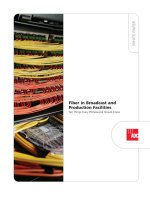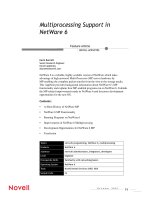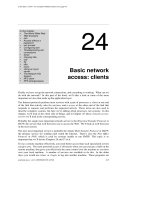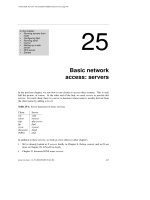Tài liệu Dramatic Attenuation in Fiber Access Terminals at Low Temperatures doc
Bạn đang xem bản rút gọn của tài liệu. Xem và tải ngay bản đầy đủ của tài liệu tại đây (39.43 KB, 2 trang )
white paper
OmniReach
™
FTTP Solutions
The Situation
It is common in applications where access terminals are used to terminate only a portion of the
fibers brought into the enclosure–allowing the remainder of the fibers to pass through. When
loose tube cable is used, the sub-units that are not terminated are "expressed" through, and
the sub-unit material is not opened at any point. To provide customers with adequate sub-unit
length for splicing under all conditions, ADC specifies a mid-span access length of 150" to
170". Testing of the enclosure with expressed sub-units of this length alerted ADC to potential
low temperature issues.
While there are no written standards governing this application, ADC has concluded that in
some - but not all - cases, loose tube OSP cable, dielectric or armored, can experience excessive
attenuation loss at low temperatures (0˚C to -40˚C). Subsequent research also reveals that the
issue becomes more severe for cables exposed to initially high temperatures (greater than 50˚C)
prior to their exposure to low temperatures. Attenuation loss can be as high as 10 to 20 dB in
extreme cases.
After identifying the problem, ADC proactively began researching the probable cause and
discovered information from a 1998 Bellcore white paper that outlined similar problems with
certain fibers in varying temperature environments. The paper, entitled "Time- and Temperature-
Dependent Material Behavior and Its Impact on Low-Temperature Performance of Fiber Optic
Cables," by Osman S. Gebizlioglu, seemed to address the very issue ADC was observing in
several of its own case studies.
According to the paper, "a series of service-affecting field failures in cold weather (-40 degrees
C to 0 degrees C) initially and in more moderate conditions (up to 15 degrees C) recently have
raised concerns about the temperature-dependent transmission performance of loose tube fiber
optic cables." The effect was transmission loss "resulting from fiber microbending due to
random fiber contacts with the buffer tube walls caused by the axial shrinkage of the buffer
tubes relative to the cable central member."
With Bellcore's previous research confirming ADC's own data, engineers set out to pinpoint and
formulate a preventative process for dealing with the issue in the field.
Dramatic Attenuation in Fiber Access Terminals
at Low Temperatures
Problem Solved
Believing that the contraction of the sub-unit could be pulling the fiber and causing microbends,
ADC set out to test the theory. Choosing a sub-unit that was exhibiting high attenuation loss at low
temperature, they stripped the sub-unit material off the entire mid-span access area. The goal was
to eliminate the clamps and panels as being part of the problem. After stripping the mid-span
section, the attenuation disappeared - thus isolating the problem to the fiber sub-unit alone.
Although this, in itself, provided a potential field solution–stripping the entire length of sub-unit
material was both labor-intensive and risky to the fiber. As a result, ADC set out to establish a craft-
friendly procedure that would simplify the solution to the problem.
Using a typical fiber cutting tool to apply "ring cuts" to the buffer tubes that are expressed through
the cabinet, the same end result is possible. The ring cut is a radial cut through the sub-unit wall
without removing material. For the mid-span length required in the ADC access terminal, three ring
cuts are applied - one at the entrance point, one at the exit point, and one in the center of the slack
loop in the mid-span access. Each ring cut is then protected by sliding a protective sleeve over the
cut - about three inches in length. Finally, a small metal "carrier" provides a method of bundling up
to six of the protective tubes together and securing them to the sides of the enclosure panel. This
prevents movement during any future maintenance activity.
Final Notes
Ribbon cable is not susceptible to the same low temperature attenuation issue since the ribbon
strands are completely removed from the center tube for accessing individual fibers. Rather, the issue
appears to be isolated to specific types of loose tube fibers, depending on each manufacturer's own
specifications.
The major variables from manufacturer to manufacturer include the sub-unit material, the sub-unit
dimensions (specifically the inner and outer diameters), the type of gel used, and the amount of
extra fiber within a sub-unit length. Any or all of these variables can present different effects in
terms of this attenuation issue.
ADC is working to help customers build reliable, high-performance networks with confidence. By
proactively addressing and solving potential problems such as these, ADC continues to reaffirm its
role as the industry leader in customer satisfaction.
References
O.S. Gebizlioglu, "Time- and Temperature-Dependent Material Behavior and Its Impact on Low-
Temperature Performance of Fiber Optic Cables." (1998)
ADC Telecommunications, Inc., P.O. Box 1101, Minneapolis, Minnesota USA 55440-1101
Specifications published here are current as of the date of publication of this document. Because we are continuously improving our products, ADC
reserves the right to change specifications without prior notice. At any time, you may verify product specifications by contacting our headquarters
office in Minneapolis. ADC Telecommunications, Inc. views its patent portfolio as an important corporate asset and vigorously enforces its patents.
Products or features contained herein may be covered by one or more U.S. or foreign patents. An Equal Opportunity Employer
1304851 9/04 Original © 2004 ADC Telecommunications, Inc. All Rights Reserved
Web Site: www.adc.com
From North America, Call Toll Free: 1-800-366-3891 • Outside of North America: +1-952-938-8080 Fax: +1-952-917-3237
For a listing of ADC’s global sales office locations, please refer to our web site.









